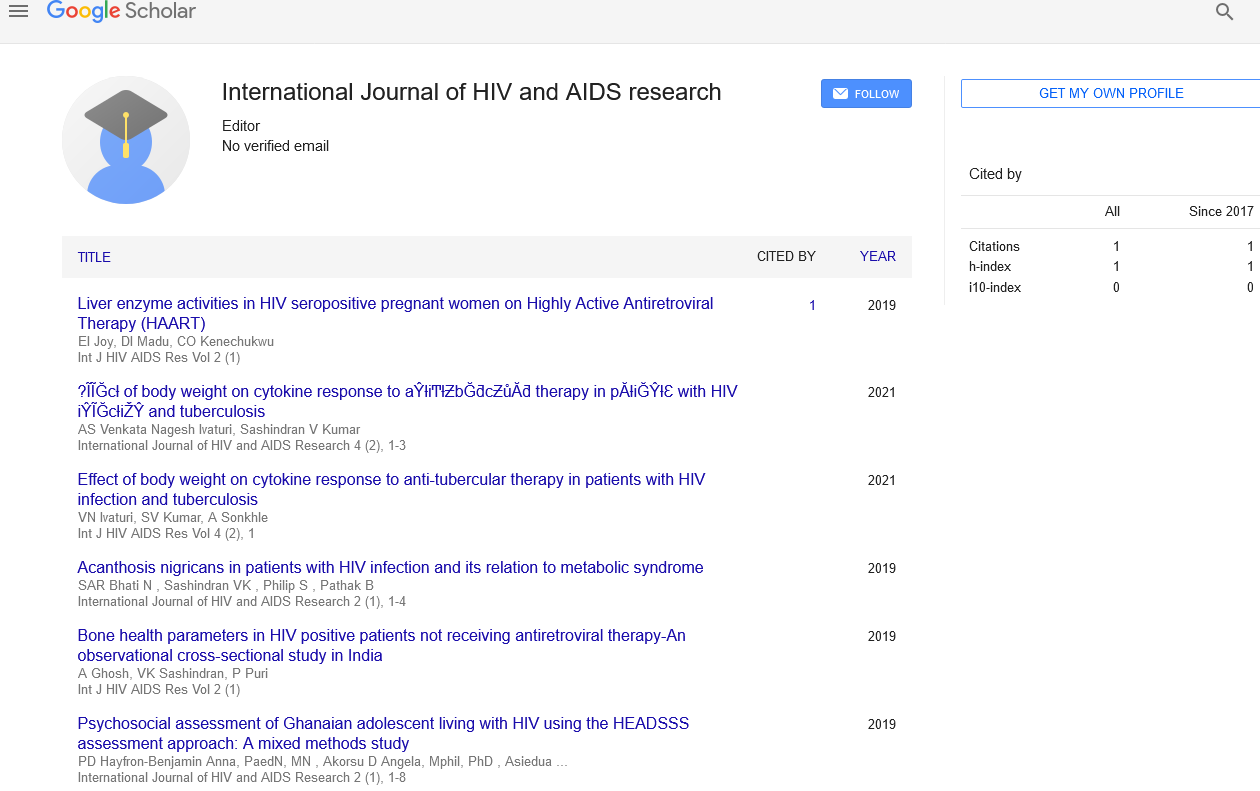Advances in HIV\AIDS research
Received: 27-Apr-2022, Manuscript No. PULIJHAR-22-4868; Editor assigned: 29-Apr-2022, Pre QC No. PULIJHAR-22-4868(PQ); Reviewed: 13-May-2022 QC No. PULIJHAR-22-4868(R); Revised: 27-Jun-2022, Manuscript No. PULIJHAR-22-4868; Published: 04-Jul-2022
Citation: Harrison R. Advances in HIV\AIDS research. J HIV AIDS Res 2022;5(3):5.
This open-access article is distributed under the terms of the Creative Commons Attribution Non-Commercial License (CC BY-NC) (http://creativecommons.org/licenses/by-nc/4.0/), which permits reuse, distribution and reproduction of the article, provided that the original work is properly cited and the reuse is restricted to noncommercial purposes. For commercial reuse, contact reprints@pulsus.com
Abstract
The Human Immunodeficiency Virus (HIV) is one of the most studied viruses in history, and investments in HIV/AIDS research have resulted in some astonishing scientific discoveries, including a better knowledge of viral biology, pathogenesis, and life-saving antiretroviral medicines. While the enormous investments in HIV/AIDS research are justified merely on the basis of these accomplishments, the broader scientific advancement that has resulted from HIV/AIDS research financing over the last 30 years is also remarkable. The positive influence has spanned basic immunology and structural biology to treatments for immune-mediated disorders and cancer, and it has had a far-reaching impact on the scientific, public, and global health communities far beyond HIV/AIDS. This article outlines a few examples of HIV/AIDS research's unanticipated and significant positive spinoffs on other scientific fields.
Keywords
HIV/AIDS; Collateral advantages
Introduction
The primary instances of AIDS were accounted for in the US 37 a long time back. From that point forward, >77 million individuals have been tainted around the world, coming about in more than 35 million passing. As of now, there are 36.9 million individuals living with human immunodeficiency infection (HIV), 1.8 million new diseases, and almost 1 million AIDS-related passings yearly. Billions of exploration dollars have been contributed toward understanding, treating, and forestalling HIV contamination. The biggest funder of HIV/AIDS research is the National Institutes of Health (NIH), putting almost $69 billion in AIDS research from financial years 1982-2018. In spite of the amazing sickness trouble, the logical advances straightforwardly coming about because of interests in AIDS research have been unprecedented. HIV is one of the most seriously examined infections ever, prompting a top to bottom comprehension of viral science and pathogenesis. Before the improvement of these life-saving medications, AIDS was a generally lethal illness. Since the show in 1987 that a solitary drug, zidovudine, otherwise called Azidothymidine or AZT, could to some degree and briefly smother infection replication, the existences of individuals living with HIV have been changed by the on-going accessibility of >30 antiretroviral drugs that, at the point when managed in mixes of 3 medications, presently in a solitary day to day pill, smother the infection to imperceptible levels. Today, on the off chance that an individual in their 20's is tainted also, given a blend of antiretroviral drugs that perpetually will strongly smother infection to beneath distinguishable levels, they can expect to carry on with an extra 50 years, permitting them right around an ordinary future. Moreover, an individual getting antiretroviral treatment with an imperceptible viral burden won't communicate infection to their uninfected sexual accomplice. This technique is alluded to as "treatment as avoidance". Additionally, organization of a solitary pill containing 2 antiretroviral drugs taken day to day by an in danger uninfected individual declines the possibility getting HIV by >95%. The gigantic interest in HIV research is plainly legitimized and approved simply based on progresses explicitly connected with HIV/AIDS. Be that as it may, the security benefits of this venture far in excess of HIV/AIDS have been significant, prompting bits of knowledge and substantial advances in isolated, different, and irrelevant fields of biomedical exploration also, medication. In the on-going Perspective, we examine a couple of select instances of the positive side projects of HIV/AIDS research on other logical regions.
Conclusion
The guarantee benefits coming about because of the significant assets dedicated to HIV/AIDS helps research throughout recent years are phenomenal. From developments in essential immunology and primary science to medicines for resistant intervened illnesses and disease, the applied and mechanical advances coming about because of HIV/AIDS research colossally affect the examination and public furthermore, worldwide wellbeing networks over and over the field of HIV/AIDS. The HIV/Helps research model has demonstrated that cross-preparation of thoughts, advancement, furthermore, research progress can prompt unexpected and significant benefits for a assortment of different sicknesses.





